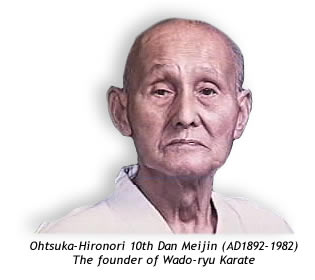About Wado Ryu Karate
Wado-Ryu (和道流) is one of the major traditional styles of Japanese karate. It is unique in its blending of traditional Okinawan karate with Japanese jujutsu principles, resulting in a fluid, evasive, and efficient martial art. The name Wado-Ryu translates to “Way of Harmony Style” (和道流), reflecting the style’s philosophical and physical emphasis on harmony rather than brute force.
🥋 Founding and History

Founder: Hironori Otsuka (1892–1982)
Year Founded: 1939, Japan
Background of the Founder:
- Otsuka was already a master in Shindō Yōshin-ryū jujutsu, a classical Japanese martial art emphasizing joint locks, throws, and body movement.
- He trained under Gichin Funakoshi, the founder of Shotokan Karate, and also studied other styles like Shito-Ryu and Goju-Ryu.
Dissatisfied with the rigidity and lack of grappling in early karate practice, he created Wado-Ryu as a synthesis of karate striking and jujutsu movement and principles.
🔍 Meaning of the Name
- Wa (和) – Harmony or peace
- Do (道) – Way or path
- Ryu (流) – Style or school
Wado-Ryu therefore means “The Way of Harmony Style.”
This name is not just symbolic—it reflects the philosophy of minimizing conflict, using an opponent’s force against them, and harmonizing with attacks rather than meeting force with force.
🧬 Core Characteristics
Emphasis on Movement (Tai Sabaki)
- Avoids direct confrontation.
- Uses body shifting, angling, and redirection to avoid attacks and create openings.
2. Blending with the Opponent
- Wado-Ryu incorporates jujutsu-like evasions, locks, and counters.
- The goal is often to unbalance the opponent rather than overpower them.
3. Kihon (Basics)
- Similar to other karate styles, including strikes, blocks, and kicks.
- Focuses on natural movement and speed over raw power.
4. Kata (Forms)
- Includes traditional kata such as Pinan (Heian) series, Kushanku, Naihanchi, Seishan, and more.
- Each kata contains fighting principles and techniques meant to be studied deeply.
5. Kumite (Sparring)
- Wado-Ryu includes both pre-arranged kumite (Yakusoku Kumite) and free sparring (Jiyu Kumite).
- Often uses techniques like nagashi-uke (sliding block) and taisabaki (body shifting) to control distance and timing.
6. Tanto Dori and Idori (Defence against weapons and from seated position)
- Reflects its jujutsu heritage.
- Includes practice against knife attacks and self-defense in various postures.
🧠 Philosophy and Principles
Wado-Ryu is not only a system of self-defence but also a way of life. Some key ideas include:
- Seiryoku Zenyo (maximum efficiency with minimum effort)
- Harmony and Non-resistance
- Personal discipline and moral development
- Adaptability – using the opponent’s strength against them
🥇 Ranking System
Like most karate styles, Wado-Ryu uses a kyu/dan ranking system:
- Kyu grades (coloured belts): Beginner to intermediate
- Dan grades (black belts): Advanced
Testing often includes kihon, kata, kumite, and sometimes bunkai (application of kata).
🌍 Organisations and Variants
Over time, different schools and federations of Wado-Ryu developed, such as:
- Wado Kai – The largest governing body for Wado-Ryu karate.
- Wado-Ryu Renmei – Originally led by Otsuka’s son, Jiro Otsuka.
- WIKF (Wado International Karate-Do Federation) – Founded by Tatsuo Suzuki, one of Otsuka’s senior students.
While all of them maintain the Wado-Ryu essence, slight differences in kata performance, teaching method, or emphasis might exist.
🤺 Comparison with Other Styles
| Feature | Wado-Ryu | Shotokan | Goju-Ryu |
| Movement | Evasive, circular | Linear, strong stances | Soft-hard blend |
| Influence | Jujutsu, Okinawan Karate | Okinawan Karate | Chinese martial arts |
| Power Generation | Speed + timing | Strength + kime | Breathing + muscle |
| Kata Variety | Medium | Extensive | Traditional & unique |
| Philosophy | Harmony and avoidance | Strength and discipline | Harmony of soft and hard |
🎥 Signature Techniques
Some signature techniques:
- Nagashi-uke (sliding/blocking redirection)
- Kuzushi (unbalancing)
- Taisabaki (evasive body shifting)
- Hikite (pulling hand to off-balance)
- Gyaku-zuki (reverse punch)
- Mawashi-geri (round kick)
